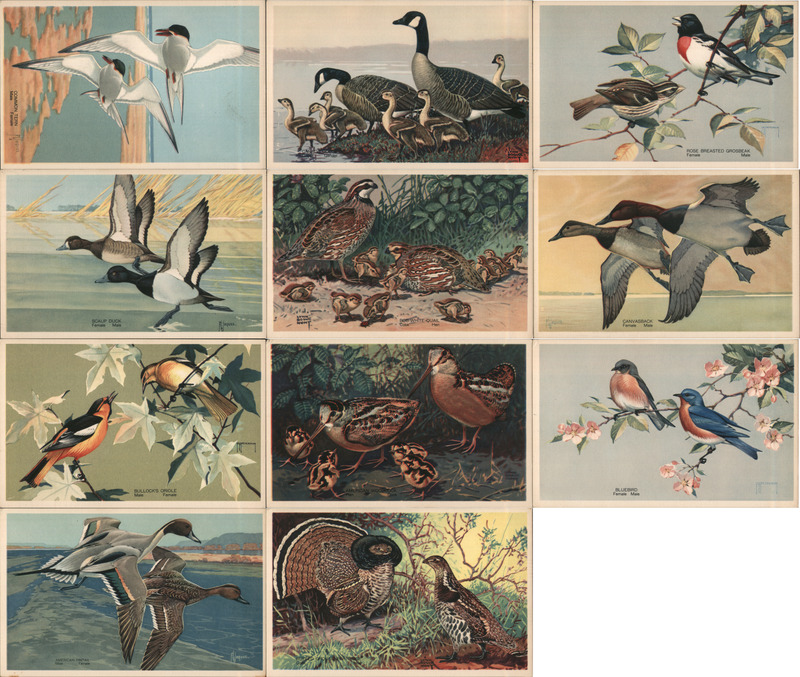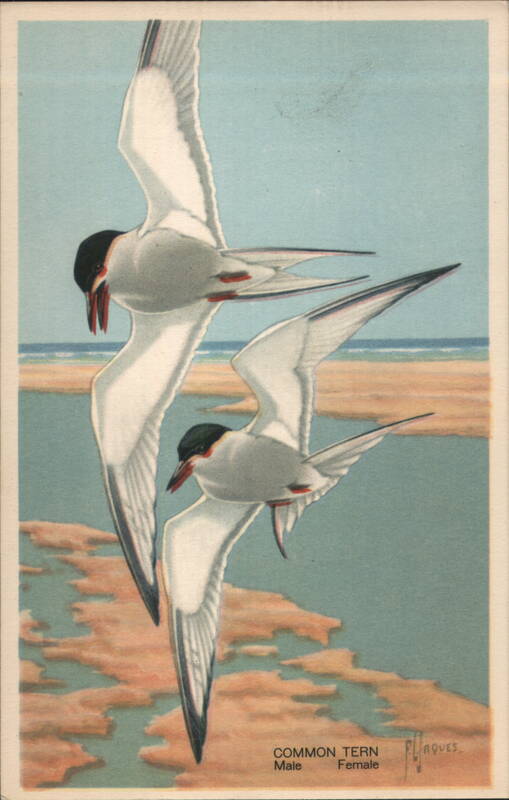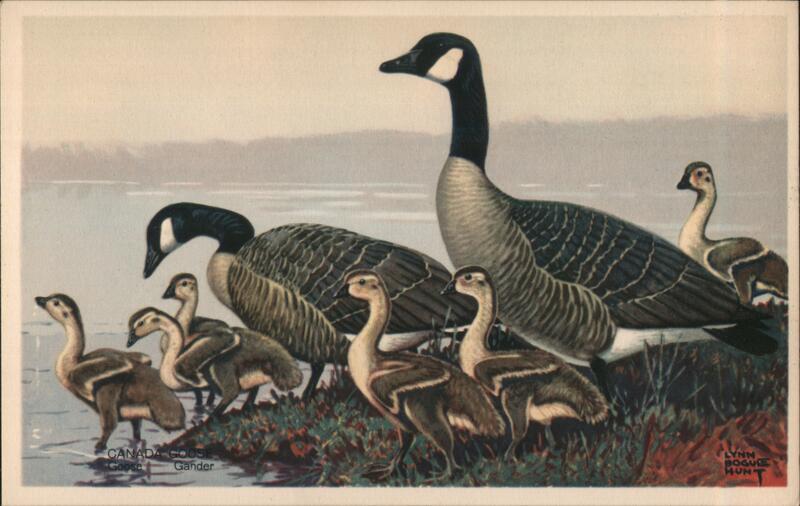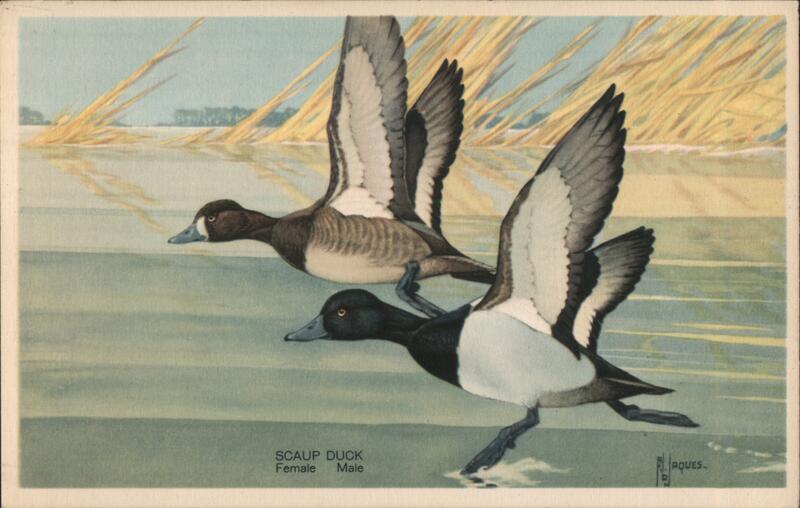Set of 12 Bird Cards America's Wildlife Resources
Additional Details:
| Set of twelve cards depicting various birds, including Common Tern (male and female), Canada Goose family, Rose-Breasted Grosbeak, Scaup Duck, California Quail family, Canvasback, Baltimore Oriole, Wood Duck family, Bluebird, Pintail Duck, Ruffed Grouse family, and Wild Turkey family. |
Front:
COMMON TERN
AQUES
Male
Female
CANADA GOOSE
Goose
Gander
LYNN
BOGUE
HUNT
ROSE BREASTED GROSBEAK
Female
Male
TPETERSON
SCAUP DUCK
Female
Male
AQUES
LYNN
BOGUE
HUNT
BOB-WHITE QUAIL
Cock
Hen
RQUES
CANVASBACK
Female Male
VA
BULLOCK'S ORIOLE
Male
Female
RIPETERSON
AMERICAN WOODCOCK
Hen
Cock
bforel
BLUEBIRD
Female Male
TERSON
AMERICAN PINTAIL
Male
Female
RUFFED GROUSE PARTRIDGE
Cock
Her
LYNN
BOGUE
HEN
412
Back:
Wildlife Post Card Series
Subject 3
RESTORE
PROTECT CONSERVE
AMERICA'S
COMMON TERN
(Sterna birundo)
WORK LIKE A BEAVER FOR RESTORATION
WILDLIFE
TRADE MARK REG V.S.PAY OFF
The flight of the Common Tern is strong,
graceful and erratic. This tern is found
in both the Old and New World, both
from the northern United States and the
Canadian provinces down the Atlantic
and Gulf coasts to Texas and in the Ba-
hamas. In winter it ranges from Florida
RESOURCES
south on the Atlantic side of
South America to Patagonia and
on the Pacific to Ecuador.
It nests preferably on sandy or gravelly
places on islands or on shores where it
frequently makes little nest except a de-
pression in the sand. The spotted eggs
number two or three; both the eggs and
the young are difficult to see on the
sand. This harmless bird eats small fish,
crustaceans, aquatic worms and insects.
NAME
Copyright 1939, National Wildlife Publishing Corp., New York
CITY
Wildlife Post Card Series
Subject 10
RESTORE
PROTECT CONSERVE
AMERICA'S
CANADA GOOSE
(Branta canadensis)
WORK LIKE A BEAVER FOR RESTORATION
WILDLIFE
TRADE MARK REG U.S.PAT.OFF.
Wedges of Geese passing overhead are
as symbolic of spring as the first Robins.
The musical "honking" of the V-shaped
flocks is a very exciting sound. These
black-necked, white-cheeked fellows are
far from being the "silly Geese" that
their barnyard brethren are. They would
not survive long in the wild, if they were
not quite intelligent.
RESOURCES
Although some Canada Geese
nest in parts of the United
States, most of them pass the sum-
mer in Canada-some as far north as
the Arctic circle. The nest is placed on a
high spot of ground, or on a little island.
Five to nine buffy-white eggs are laid
on a bedding of down. The newly-
hatched Goslings are buffy yellow.
Several races of Canada Geese are
recognized-one, the Cackling Goose,
which spends the winter in California, is
almost as small as a Mallard Duck.
NAME
Copyright 1939, National Wildlife Publishing Corp., New York
CITY
Wildlife Post Card Series
Subject 12
RESTORE
PROTECT CONSERVE
AMERICA'S
ROSE-BREASTED
GROSBEAK
(Hedymeles ludovicanus)
WORK LIKE A BEAVER FOR RESTORATION
WILDLIFE
TRADE MARK REG. N.S.PAT OFF
The black and white male, with his large
triangular breast-patch of rose-red, is one
of the most beautiful of eastern birds.
His mate is quite different, more like a
large overgrown Sparrow, buf with a
much larger bill than any Sparrow has.
The male's reputation as a singer lives
up to his beauty. His song resembles the
RESOURCES
carolling of a Robin but is
smoother, more melodious -
one of the pleasantest bird songs to
be heard in the June Woodlands.
The nest is built from 6' to 20' from the
ground, in a shrub or small tree. The
three to five greenish eggs are spotted
and blotched with brown.
The Rose-breast is found in the sum-
mer east of the Rocky Mountains, from
the central states north to central Mani-
toba and southern Quebec. It migrates
to southern Mexico and South America.
NAME
Copyright 1939, National Wildlife Publishing Corp., New York
CITY
Wildlife Post Card Series
Subject 7
RESTORE
PROTECT -
CONSERVE
AMERICA'S
THE SCAUP DUCK
(Nyroca marila)
WORK LIKE A BEAVER FOR RESTORATION
WILDLIFE
TRADE MARK REG U.S. PAY OFF
The two kinds of Scaup Ducks, also
known as "Bluebills" or "Broadbills,"
are the bay Ducks that look black at both
ends and white in the middle, when sit-
ting on the water. Sometimes when they
raft in large numbers, the water fairly
boils with the diving and swimming
birds. It seems as though they must
surely collide down below.
RESOURCES
The Greater Scaup and Lesser
Scaup are very much alike in
appearance, but the Greater has a
greenish-glossed head; the head of the
Lesser is glossed with purple.
Both species nest principally in Can-
ada. The Greater Scaup is the winter
Scaup of the North Atlantic coast from
southern New England to North Caro-
lina. It also winters along the Pacific
coast, and some migrate through the
interior to the Gulf of Mexico.
Copyright 1939, National Wildlife Publishing Corp., New York
NAME
CITY
HERE
Wildlife Post Card Series
Subject 2
RESTORE
PROTECT
CONSERVE
AMERICA'S
BOB-WHITE QUAIL
(Colinus virginianus)
WORK LIKE A BEAVER FOR RESTORATION
WILDLIFE
TRADE MARK REG US.PAT.OF.
Bob-white Quail, one of America's best
loved birds, make their homes close to
man, and even do well in vacant lots at
the edge of cities. They have followed
cultivation northward and westward, are
active friends of the farmer because of
the weed seeds and insects they
RESOURCES
destroy. Bob-white needs a
combination of thicket and
open fields. In the north, sleet
storms that coat with ice the plants bear-
ing seeds and winter berries sometimes
wipe out the Bob-white. The name comes
from the mating whistle of the male bird.
Bob-white is a model father, will help
hatch the eggs and will rear the baby
Quail if they are left motherless.
NAME
Copyright 1939, National Wildlife Publishing Corp., New York
CITY
Wildlife Post Card Series
Subject 9
RESTORE
PROTEST CONSERVE
AMERICA'S
THE CANVASBACK
(Nyroca valisineria)
WORK LIKE A BEAVER FOR RESTORATION
WILDLIFE
TRADE MARK REG. V.S.PAY OFF
Canvasbacks riding the waves, their
white backs flashing and rusty heads
catching the sunlight are as handsome
as any of the waterfowl. On the wing,
heading into the wind, their long necks
and long bills give them a slender look
as if the wings were set far back.
In recent years, drought, drainage and
other agencies have reduced the num-
RESOURCES
bers of Canvasbacks so
alarmingly that it has been a
matter of concern to many people.
Although Canvasbacks are found
throughout a large part of the United
States during migration, and along both
coasts in winter, they nest principally in
the interior and western parts of North
America, in prairie regions, from Alaska,
Saskatchewan and western Manitoba
south to Oregon, Nevada, northern New
Mexico and Minnesota.
NAME
Copyright 1939, National Wildlife Publishing Corp., New York
CITY
Wildlife Post Card Series
Subject 6
RESTORE
PROTECT CONSERVE
AMERICA'S
WORK LIKE A BEAVER FOR RESTORATION
WILDLIFE
RESOURCES
TRADE MARK REG. US Pat.or
BULLOCK'S ORIOLE
(Icterus bullocki)
This is the common Oriole or "Fire Bird"
of much of the West, and it may be dis-
tinguished from other American Orioles
by the black crown and large white
wing patches.
The nest is a cup-like affair, hanging
from the tips of the branches, from 6 to
40 feet from the ground, generally in
cotton woods or willows. The
three to six eggs are bluish-white
or pale buffy, lined and scrawled
with blackish. If you put out a supply of
string, yarn or floss, and cut it into ten
inch lengths, Orioles will sometimes use
it for nest-building.
In the summertime, this species
ranges as far north as southern British
Columbia and southern Saskatchewan.
It winters in Mexico.
NAME
Copyright 1939, National Wildlife Publishing Corp., New York
CITY
Wildlife Post Card Series
Subject 15
RESTORE
PROTECT CONSERVE
AMERICA'S
WOODCOCK
(Philohela minor)
WORK LIKE A BEAVER FOR RESTORATION
WILDLIFE
TRADE MARK REG U.S.PAT.Org
This quaintly beautiful game-bird of the
swampy thicket has mysterious ways
that scientists are studying. It is now be-
lieved that one thing needed to attract
Woodcock are dancing grounds, suitable
clearings in the thickets where the male
can perform his courting antics in the
RESOURCES
air. The female Woodcock
carries the downy young from
a place of danger, flying with them,
one at a time, between her thighs. The
Woodcock breeds in the northeastern
United States and eastern Canada, and
winters far enough south to find soft
earth for its flexible probing bill. Wood-
cock diet is almost 100 percent angle-
worms.
NAME
Copyright 1939, National Wildlife Publishing Corp., New York
CITY
Wildlife Post Card Series
Subject 14
RESTORE
PROTECT CONSERVE
AMERICA'S
THE BLUEBIRD
(Sialia Sialis)
WORK LIKE A BEAVER FOR RESTORATION
WILDLIFE
TRADE MARK REGU.S.PAT.OFF.
In the North, the simple warbled notes
of Bluebirds are among the first spring
sounds. In the South, they can be heard
the year around.
Blue Jays have white breasts; Indigo
Buntings, blue breasts; Bluebirds, rusty-
red breasts. That is the simplest way to
tell this blue trio apart.
Bluebirds nest in cavities, in trees,
RESOURCES
old Woodpecker holes or
bird boxes. Four or five pale
blue eggs are laid. Boxes for them
should be 5" x 5" x 8" deep, with a hole
placed above center 1½" in diameter,
small enough to keep out the Starlings.
The house should be put up on a pole
about 5' or 6' from the ground, in a
sunny open place.
The Western Bluebird is very similar
but has a chestnut patch in the center of
the back.
NAME
Copyright 1939, National Wildlife Publishing Corp., New York
CITY
Wildlife Post Card Series
Subject 13
RESTORE
PROTECT CONSERVE
AMERICA'S
AMERICAN PINTAIL
(Anas acuta tzitzihoa linnaeus)
WORK LIKE A BEAVER FOR RESTORATION
WILDLIFE
TRADE MARK REG US.PAT.OFF
The Pintail, aptly called the greyhound
of water fowl, is a swift-flying, agile,
hardy species. The male is attractively
garbed in a most effective blending of
gray, white and brown, surpassing many
other birds of more gaudy hues. The
Pintail breeds from Alaska and James
Bay to California and, rarely, Pennsyl-
vania; and winters from British Columbia
RESOURCES
and New York to the West
Indies and Panama; also in
Hawaiian Islands. These ducks
arrive at their breeding grounds
very early, sometimes before the ice
is out of the lakes, and their eggs, seven
to ten in number and pale greenish to
olive buff in color, are laid in late March
or April, the young being fully fledged
in late June.
The species has increased wonder-
fully since spring shooting was out-
lawed by Federal law. Pintails are very
fond of grain for winter feed.
NAME
Copyright 1939, National Wildlife Publishing Corp., New York
CITY
HERE
Wildlife Post Card Series
Subject 11
RESTORE
PROTECT CONSERVE
AMERICA'S
RUFFED GROUSE
(Bonasa umbellus)
WORK LIKE A BEAVER FOR RESTORATION
WILDLIFE
TRADE MARK REC. 4.S.PAT OFF
The Ruffed Grouse is about the size of a
Bantam Rooster and is found in all wood-
lands of our northern states and in Can-
ada from the Maritime Provinces to
Alaska. In our eastern states it goes
south to Georgia in the mountains.
The nest is a few dead leaves scraped
together and may contain from eight to
fourteen buffy eggs, sometimes with
RESOURCES
brown speckles. The little
downy chicks can run about for
food at once.
During the mating season, April and
May, the male makes a curious drum-
ming sound by rapidly beating his
wings against the air as he stands erect
on a log or stone.
The Grouse eats seeds, berries, buds
and insects. It is a wild, shy bird, but
thrives in the neighborhood of man if
not too much disturbed.
NAME
Copyright 1939, National Wildlife Publishing Corp., New York
CITY
























